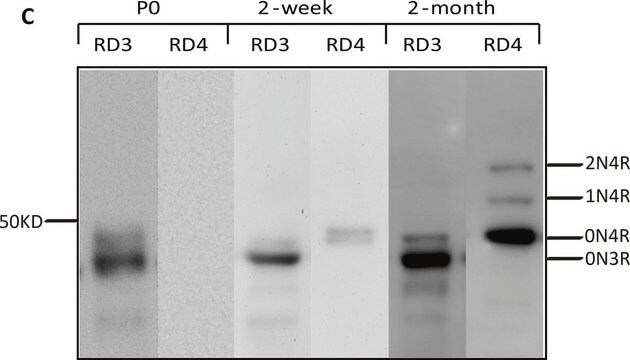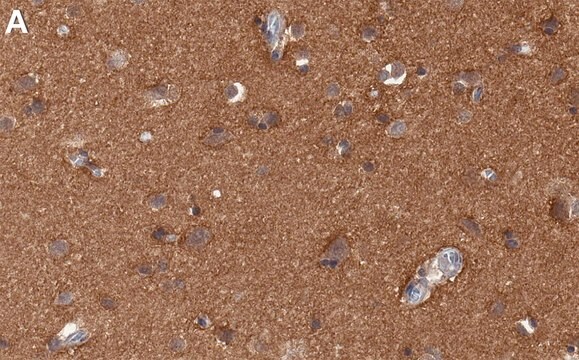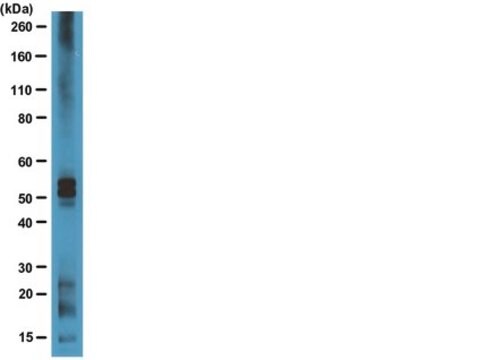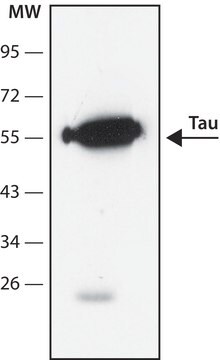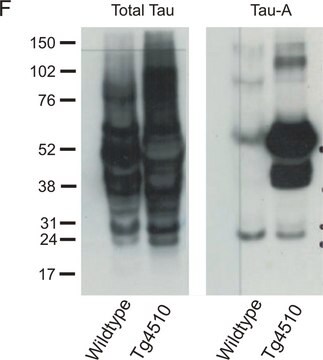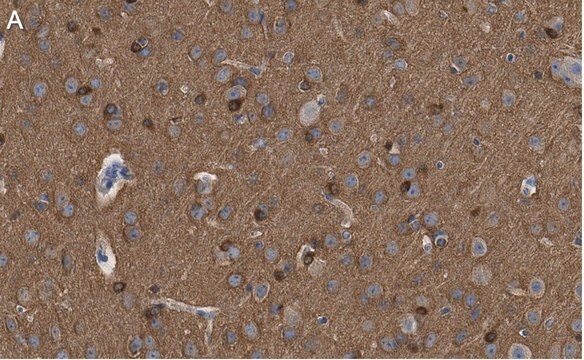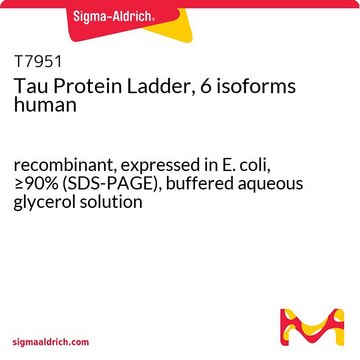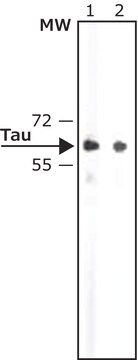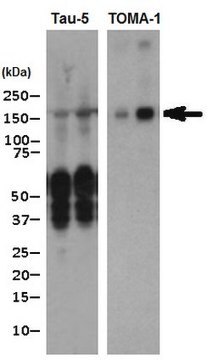MAB2241
ANTI-TAU (MAPT) Antibody
mouse monoclonal, Tau 12
동의어(들):
G protein beta1/gamma2 subunit-interacting factor 1, Neurofibrillary tangle protein, Paired helical filament-tau, microtubule-associated protein tau, microtubule-associated protein tau, isoform 4
로그인조직 및 계약 가격 보기
모든 사진(1)
About This Item
UNSPSC 코드:
12352203
eCl@ss:
32160702
NACRES:
NA.41
추천 제품
일반 설명
Microtubule Associated Proteins, or MAPS, bind to the tubulin subunits of microtubule structures and regulate their functional stability. In the cell MAPs bind to monomer and multimerized tubulin. MAP binding to multimerized tubulin further stabilizes the formation of higher order microtubulin structures. MAP binding to microtubule structures is mediated through phosphorylation through Microtubule Affinity Regulated Kinase (MARK). Phosphorylation releases MAPs bound to microtubules, destabilizing the structure, driving it toward disassembly. There are predominately two MAP types, I, II. Type II MAP includes MAP2, MAP4, and tau and are found in nervous tissue. Six tau isoforms exist in brain tissue, and they are distinguished by their number of binding domains. Three isoforms have three binding domains and the other three have four binding domains. The binding domains are located in the carboxy-terminus of the protein and are positively-charged (allowing it to bind to the negatively-charged microtubule). The isoforms with four binding domains are better at stabilizing microtubules than those with three binding domains.
특이성
Cat. # MAB2241 recognizes the N-terminus region of Tau.
Reactivity with other species has not been determined.
면역원
Epitope: N-terminus
KLH conjugated synthetic linear peptide.
애플리케이션
Anti-Tau Antibody, clone Tau 12 is an antibody against Tau for use in WB.
Research Category
Neuroscience
Neuroscience
Research Sub Category
Neurodegenerative Diseases
Neurodegenerative Diseases
품질
Western Blot:
표적 설명
50-68 kDa
결합
Replaces: MAB10417
물리적 형태
Format: Purified
Protein G Purified
Purified in 0.1M Tris-Glycine (pH7.4) 150mM NaCl with 0.05% NaN3.
저장 및 안정성
Stable for 1 year at 2-8ºC from date of receipt.
분석 메모
Control
Human brain tissue lysate.
Human brain tissue lysate.
기타 정보
Concentration: Please refer to the Certificate of Analysis for the lot-specific concentration.
면책조항
Unless otherwise stated in our catalog or other company documentation accompanying the product(s), our products are intended for research use only and are not to be used for any other purpose, which includes but is not limited to, unauthorized commercial uses, in vitro diagnostic uses, ex vivo or in vivo therapeutic uses or any type of consumption or application to humans or animals.
Storage Class Code
12 - Non Combustible Liquids
WGK
WGK 1
Flash Point (°F)
Not applicable
Flash Point (°C)
Not applicable
시험 성적서(COA)
제품의 로트/배치 번호를 입력하여 시험 성적서(COA)을 검색하십시오. 로트 및 배치 번호는 제품 라벨에 있는 ‘로트’ 또는 ‘배치’라는 용어 뒤에서 찾을 수 있습니다.
Hiroki Takeuchi et al.
NPJ vaccines, 5, 28-28 (2020-03-29)
Pathological aggregates of tau proteins accumulate in the brains of neurodegenerative tauopathies including Alzheimer's disease and frontotemporal lobar degeneration (FTLD-tau). Although immunotherapies of these disorders against tau are emerging, it is unknown whether nasal delivery, which offers many benefits over
April L Darling et al.
Protein science : a publication of the Protein Society, 30(7), 1350-1359 (2021-03-10)
Alzheimer's disease is a progressive fatal neurodegenerative disease with no cure or effective treatments. The hallmarks of disease include extracellular plaques and intracellular tangles of aggregated protein. The intracellular tangles consist of the microtubule associated protein tau. Preventing the pathological
Jessica L Binder et al.
PloS one, 15(3), e0230026-e0230026 (2020-03-26)
Pathological accumulation of microtubule associated protein tau in neurons is a major neuropathological hallmark of Alzheimer's disease (AD) and related tauopathies. Several attempts have been made to promote clearance of pathological tau (p-Tau) from neurons. Transcription factor EB (TFEB) has
Deepa Ajit et al.
The Journal of biological chemistry, 294(45), 16698-16711 (2019-09-24)
Abnormal intracellular accumulation of aggregated tau is a hallmark feature of Alzheimer's disease and other tauopathies. Pathological tau can undergo a range of post-translational modifications (PTMs) that are implicated as triggers of disease pathology. Recent studies now indicate that tau
Carmen Romero-Molina et al.
Frontiers in cellular neuroscience, 12, 421-421 (2018-11-30)
Microglial cells are crucial players in the pathological process of neurodegenerative diseases, such as Alzheimer's disease (AD). Microglial response in AD has been principally studied in relation to amyloid-beta pathology but, comparatively, little is known about inflammatory processes associated to
자사의 과학자팀은 생명 과학, 재료 과학, 화학 합성, 크로마토그래피, 분석 및 기타 많은 영역을 포함한 모든 과학 분야에 경험이 있습니다..
고객지원팀으로 연락바랍니다.